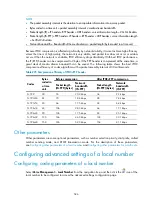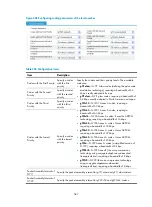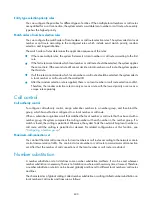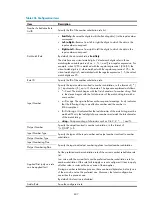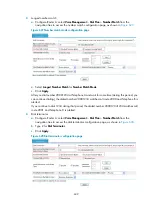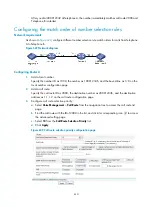
600
Entity type selection priority rules
You can configure the priorities for different types of entities. When multiple local numbers or call routes
are qualified for a call connection, the system selects a suitable local number or call route whose entity
type has the highest priority.
Match order of number selection rules
You can configure the match order of local number or call route selection rules. The system selects a local
number or call route according to the configured rules, which include exact match, priority, random
selection, and longest idle time.
The match order of rules determines the application sequence of the rules:
•
If there are multiple rules, the system first selects a local number or call route according to the first
rule.
•
If the first rule cannot decide which local number or call route should be selected, the system applies
the second rule. If the second rule still cannot decide a local number or call route, the system applies
the third rule.
•
If all the rules cannot decide which local number or call route should be selected, the system selects
a local number or call route with the smallest ID.
•
After the random selection rule is applied, there is no local number or call route selection conflict.
Therefore, the random selection rule can only serve as a rule with the lowest priority or serve as a
unique rule separately.
Call control
Call authority control
To configure call authority control, assign subscriber numbers to a number group, and then bind the
group, which has authorities configured, to a local number or call route.
When a subscriber originates a call that matches the local number or call route that has bound with a
number group, the system compares the calling number with each number in the number group. If a
match is found, the calling is permitted. Otherwise, the system finds the next matching local number or
call route until the calling is permitted or denied. For related configurations of this function, see
"
Maximum-call-connection set
You can limit the total call connections for local numbers or call routes according to the network scale to
control communication traffic. You can bind a local number or call route to a maximum-call-connection
set. After that, the number of call connections of the local number or call route is restricted.
Number substitution
A number substitution rule list defines some number substitution methods. It can be used wherever
number substitution is necessary. There is no limitation on where and how many times it is used. Therefore,
a number substitution rule list can be bound globally and bound to different local numbers/call routes
and lines.
The characteristics of global calling/called number substitution or calling/called number substitution on
local numbers/call routes and lines are as follows:
Summary of Contents for MSR SERIES
Page 17: ...xv Documents 835 Websites 835 Conventions 836 Index 838 ...
Page 20: ...3 Figure 3 Initial page of the Web interface ...
Page 42: ...25 Figure 13 Firefox Web browser setting ...
Page 59: ...42 Figure 27 Checking the basic service configuration ...
Page 73: ...56 Figure 35 Sample interface statistics ...
Page 156: ...139 Figure 139 Rebooting the 3G modem ...
Page 168: ...151 Figure 152 Configuring Web server 2 ...
Page 174: ...157 Figure 158 Configure the URL filtering function ...
Page 242: ...225 Figure 233 Enabling the DHCP client on interface Ethernet 0 1 ...
Page 247: ...230 Figure 236 The page for configuring an advanced IPv4 ACL ...
Page 255: ...238 Figure 241 Advanced limit setting ...
Page 298: ...281 e Click Apply 2 Configure Router B in the same way Router A is configured ...
Page 400: ...383 Figure 387 Verifying the configuration ...
Page 405: ...388 ...
Page 523: ...506 Figure 530 Ping configuration page ...
Page 775: ...758 Figure 785 Configuring a jump node ...

